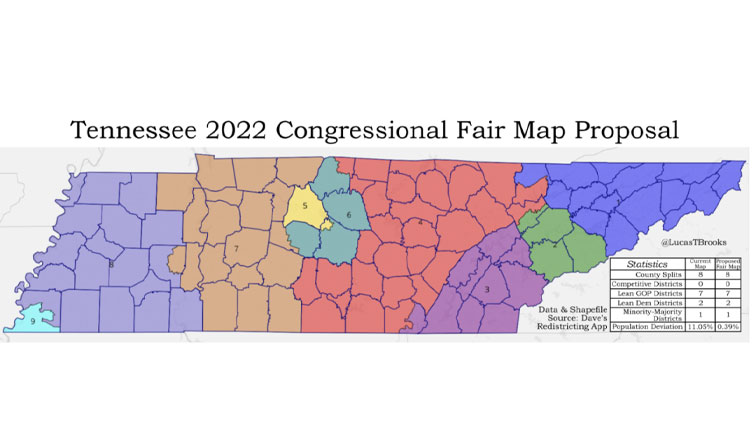Image: Schematic of a potential non-partisan gerrymandered congressional district map. Image Credit: Lucas Brooks
By Dulce Torres Guzman [The Tennessee Lookout CC BY-NC-ND 4.0] –
State legislators have until next year to finish redistricting the state, but the pressure is on local officials to quickly finish a process that will closely affect Tennessee residents on a day to day basis.. Here’s what the redistricting process looks like across the state.
Metropolitan Nashville and Davidson County
There’s no question that Nashville’s population has boomed over the past 10 years, since the last census. The 2020 Census data revealed the city’s population grew from 626,681 to 715,884 at a growth rate of 14.2%, or twice the rate of the country overall, according to Metro Nashville. Growth occurred throughout Metro Nashville and Davidson County, but the biggest population swing happened in South Nashville and the urban core, which coincides with growing communities of color.
When the census data was released in August, population shifts caused districts to become unequal, with north and east districts being below ideal population numbers in comparison to south Davidson County districts.
Districts 5 and 6 are currently facing shifts considering they’re at 92% of the average district size of 20,454 residents, and possible solutions include both districts being stretched across the river over the I-65 bridge. Because of this, areas such as Councilmember Russ Bradford’s District 13 face getting carved, causing concerns about ensuring ethnic populations have representation.
Redistricting maps were first released in October and Metro Nashville officials have since held several community meetings for public feedback. Since Nashville has a consolidated form of government, there is only one redistricting process for the city and the county.
Metro Nashville is currently in phase four of their redistricting process and released a second draft of council districts on Friday. Greg Claxton from the Metro Nashville Planning Department said there will be another review and comment period for this draft before the Metro Council gets to vote on a final version.
The new proposal took into consideration comments made to keep communities of interest together, such as reconnecting neighborhoods on either side of Brick Church Pike by extending District 3 boundaries to I-24.
If the current proposal receives approval from the council the planning commission can begin the adoption process this month, said Claxton. Otherwise, the proposal remains open to public review online.
*** Click Here to Support Conservative Journalism in Tennessee. We can’t bring you stories like this without your support!***
Memphis and Shelby County
Shelby County’s population has increased just slightly over the past 10 years—from 927,644 in 2010 to 929,744 in 2020. Population changes have instead shifted across the county, leading to some areas experiencing significant growth and others losing population numbers.
In Memphis, a city of seven council districts and six super districts, three city council districts had population growth while four others faced losses. Citywide, population numbers dropped 16,000 in the last 10 years with population shifting from one place to another. Districts 1, 3 and 5 grew and faced cuts during the redrawing process. Districts 2, 4, 6 and 7 declined.
Officials are focused on keeping most of District 1’s Cordova-section together, which has experienced the most growth.
Shelby County also experienced population shifts. For instance, District 2 experienced the largest growth, from 72,437 in 2010 to 80,616 in 2020, according to Darrick Harris with the Memphis and Shelby County Division of Planning.
Other districts faced significant declines in population. District 10 decreased from 71,842 to 65,018. As of last week, commissioners ultimately voted to keep their 13 district, 13 commissioner plan, but continued to debate which map would receive final approval.
Harris created nine out of 10 maps up for consideration with an ideal population of 71,519 per district with a less than 10% deviation. Harris said he and his department kept in mind communities of interest and political boundaries and hosted public meetings allowing residents to submit their own maps.
Still, not everyone was satisfied. County Commissioner Tami Sawyer took issue with one publicly-submitted map, noting it was drawn up by the Shelby County Republican Party.
Along with Cordova’s growth, several areas of Shelby County face significant changes. Germantown and Collierville face splits. Another map has drawn both Commissioners Michael Whaley and Brandon Morrison into District 13, causing concerns that they’ll be competing against one another. Both are up for reelection in 2022.
Facing a Nov. 8 deadline, Shelby County commissioners hit a roadblock on Nov. 1 while attempting a third vote and a special commission was called on Nov. 8 for a fourth vote.
Knoxville and Knox County
Knoxville, a city with six districts, has had steady growth since 2010. Over the last decade, the city’s population grew from 178,874 in 2010 to 190,740 in 2020, according to the Knoxville/Knox County Planning Commission. Ethnic diversity also grew: Latinos now account for 7.9% of the population and African Americans account for 16% of the population. With other races factoring in, minorities make up 30.4% of the city’s population.
During the redistricting process, officials attempted to keep an ideal population of 31,790 per district with an overall deviation of 8.6%. District 2 has the largest population at 33,013, and District 6 has the largest minority population at 57.3% of the total population.
Knoxville recently held general elections, with five incumbents facing challengers. All five won their districts, including Tommy Smith (District 1), Andrew Roberto (District 2), Seema Singh (District 3), Lauren Rider (District 4) and Gwen McKenzie (District 6).
The Knoxville City Council adopted their redistricting ordinance on Nov. 2 and given that the overall deviation was less than 10%, council members were not required to redistrict, according to Will Johnson, the city recorder. Essentially, the city council readopted the 2011 map following the 2010 census.
Knox County has nine county commission districts with a total population of 477,857. The ideal population per district is 53,095 with a current overall deviation of 22.6%, according to the Knox County Commission.
The proposed map 3B was approved on two readings with 42,588 of the population shifted in order to create a 6.8% deviation. Currently map 3B is being sent to the state comptroller for final approval, per Knox County’s plan, said Richie Beeler, a county commissioner. The law department should receive notice in the next few weeks of the comptroller’s decision.
Chattanooga and Hamilton County
Hamilton County’s population rose significantly from 336,463 in 2010 to 366,207 in 2020, leading county commissioners to reconsider the current district lines. Chattanooga’s population also experienced significant growth, from 167,674 in 2010 to 181,099 in 2020.
The Hamilton County commission has until Jan.1, 2022 to complete redistricting. The group approved a map expanding the commission from nine to 11 districts, leaving two new county commission seats up for grabs in next year’s elections. East Chattanooga and parts of downtown previously located in District 4 have now shifted under the new map to make way for District 11.
The maps will now have to be sent to the state for legal approval before they can be used in next year’s elections. County Commissioners next will decide whether the Hamilton County School Board will use the same redistricting maps or if they will require separate maps.
In Chattanooga, the city council has to spend at least six months completing their redistricting process, according to their charter. Because Chattanooga’s next elections aren’t until March 2025, the city council has been given until March 2024 to complete redistricting maps, said Mary Beth Ikard, spokesperson for Mayor Tim Kelly.
Councilmember Carol Berz will serve as chair of the redistricting committee, which is currently looking at the census data. As of now, the committee is not planning on adding districts but will change district lines.
For more information on redistricting:
- Metropolitan Nashville/Davidson County
- Memphis/Shelby County
- Chattanooga/Hamilton County
- Knoxville
- Knox County

About the Author: Dulce Torres Guzman has written for the Nashville Scene and Crucero News. A graduate of Middle Tennessee State University, she received the John Seigenthaler Award for Outstanding Graduate in Print Journalism in 2016. Follow Guzman on Twitter @Dulcet24





